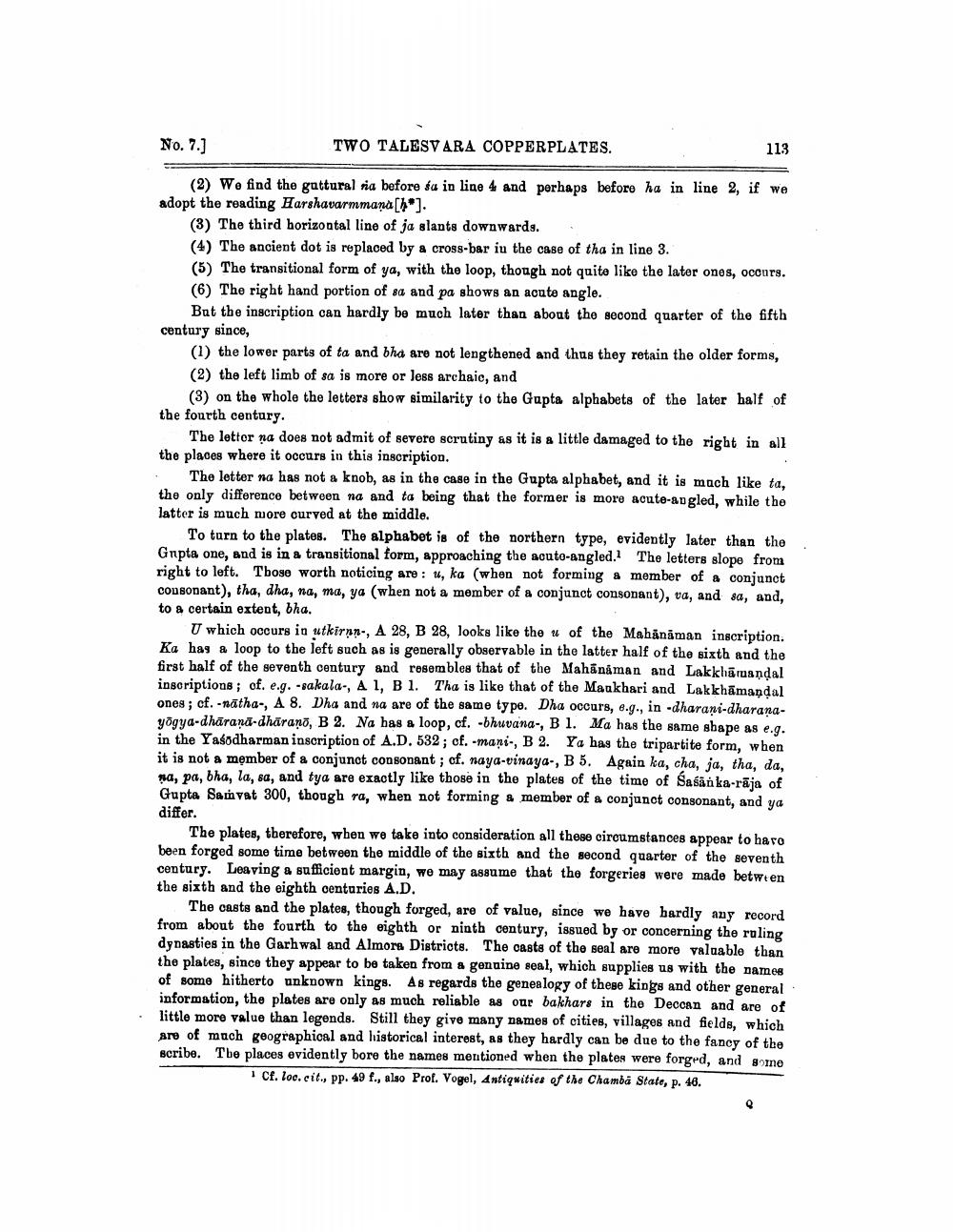________________
No. 7.]
TWO TALESVARA COPPERPLATES.
(2) We find the guttural ria before sa in line 4 and perhaps before ha in line 2, if we adopt the reading Harshavarmmana [*].
(3) The third horizontal line of ja slants downwards.
113
(4) The ancient dot is replaced by a cross-bar in the case of tha in line 3.
(5) The transitional form of ya, with the loop, though not quite like the later ones, occurs.
(6) The right hand portion of sa and pa shows an acute angle.
But the inscription can hardly be much later than about the second quarter of the fifth century since,
(1) the lower parts of ta and bha are not lengthened and thus they retain the older forms,
(2) the left limb of sa is more or less archaic, and
(3) on the whole the letters show similarity to the Gupta alphabets of the later half of the fourth century.
The letter na does not admit of severe scrutiny as it is a little damaged to the right in all the places where it occurs in this inscription.
The letter na has not a knob, as in the case in the Gupta alphabet, and it is much like ta, the only difference between na and to being that the former is more acute-angled, while the latter is much more curved at the middle.
To turn to the plates. The alphabet is of the northern type, evidently later than the Gupta one, and is in a transitional form, approaching the acute-angled. The letters slope from right to left. Those worth noticing are: u, ka (when not forming a member of a conjunct consonant), tha, dha, na, ma, ya (when not a member of a conjunct consonant), va, and sa, and, to a certain extent, bha.
U which occurs in utkiran-, A 28, B 28, looks like the u of the Mahanaman inscription. Ka has a loop to the left such as is generally observable in the latter half of the sixth and the first half of the seventh century and resembles that of the Mahanaman and Lakkhamandal inscriptions; of. e.g. -sakala-, A 1, B 1. Tha is like that of the Maukhari and Lakkhamandal ones; cf. -natha-, A 8. Dha and na are of the same type. Dha occurs, e.g., in -dharani-dharanayogya-dharana-dharano, B 2. Na has a loop, cf. -bhuvana-, B 1. Ma has the same shape as e.g. in the Yasodharman inscription of A.D. 532; cf. -mani-, B 2. Ya has the tripartite form, when it is not a member of a conjunct consonant; cf. naya-vinaya-, B 5. Again ka, cha, ja, tha, da, na, pa, bha, la, sa, and tya are exactly like those in the plates of the time of Sasanka-raja of Gupta Samvat 300, though ra, when not forming a member of a conjunct consonant, and ya
differ.
The plates, therefore, when we take into consideration all these circumstances appear to have been forged some time between the middle of the sixth and the second quarter of the seventh century. Leaving a sufficient margin, we may assume that the forgeries were made between the sixth and the eighth centuries A.D.
The casts and the plates, though forged, are of value, since we have hardly any record from about the fourth to the eighth or ninth century, issued by or concerning the ruling dynasties in the Garhwal and Almora Districts. The casts of the seal are more valuable than the plates, since they appear to be taken from a genuine seal, which supplies us with the names of some hitherto unknown kings. As regards the genealogy of these kings and other general information, the plates are only as much reliable as our bakhars in the Deccan and are of little more value than legends. Still they give many names of cities, villages and fields, which are of much geographical and historical interest, as they hardly can be due to the fancy of the scribe. The places evidently bore the names mentioned when the plates were forged, and some
1 Cf. loc. cit., pp. 49 f., also Prof. Vogel, Antiquities of the Chamba State, p. 46.




